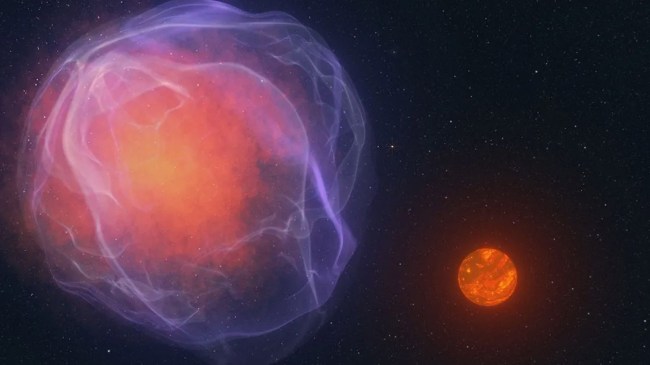W.M. Keck Observatory/Adam Makarenko
A mysterious object that is 27,306 times the size of Earth has been spotted flying through space at one million miles per hour, NASA reports.
The object (CWISE J1249), discovered by citizen scientists working on NASA’s Backyard Worlds: Planet 9 project, is “moving so fast that it will escape the Milky Way’s gravity and shoot into intergalactic space,” according to a press release.
“This hypervelocity object is the first such object found with the mass similar to or less than that of a small star,” the NASA Science Editorial Team wrote.
The mysterious CWISE J1249 is currently 400 light years from Earth (one light year is six trillion miles).
“I can’t describe the level of excitement,” said Martin Kabatnik, one of the citizen scientists who discovered the object along with Thomas P. Bickle and Dan Caselden. “When I first saw how fast it was moving, I was convinced it must have been reported already.”
So what is it exactly? Not even NASA knows for sure.
CWISE J1249 is zooming out of the Milky Way at about 1 million miles per hour. But it also stands out for its low mass, which makes it difficult to classify as a celestial object. It could be a low-mass star, or if it doesn’t steadily fuse hydrogen in its core, it would be considered a brown dwarf, putting it somewhere between a gas giant planet and a star.
NASA also explained that the object’s unusual composition, it contains much less iron and other metals than other stars and brown dwarfs, suggests that it is “likely from one of the first generations of stars in our galaxy.”
So why is it going so fast?
One hypothesis is that CWISE J1249 originally came from a binary system with a white dwarf, which exploded as a supernova when it pulled off too much material from its companion. Another possibility is that it came from a tightly bound cluster of stars called a globular cluster, and a chance meeting with a pair of black holes sent it soaring away.
“When a star encounters a black hole binary, the complex dynamics of this three-body interaction can toss that star right out of the globular cluster,” says Kyle Kremer, incoming assistant professor in UC San Diego’s Department of Astronomy and Astrophysics.
“To put the speed of J1249 into perspective, it is moving 2.6 times faster than the fastest space probe ever launched, which is the speed that the Parker space probe reached when it looped around the Sun in June 2024,” Dr. Darren Baskill, astronomy lecturer at the University of Sussex, told BBC Science Focus.
A study on it conducted by university academics and government scientists, including members of the NASA Goddard Space Flight Center, is awaiting peer review at Cornell’s arXiv site.

